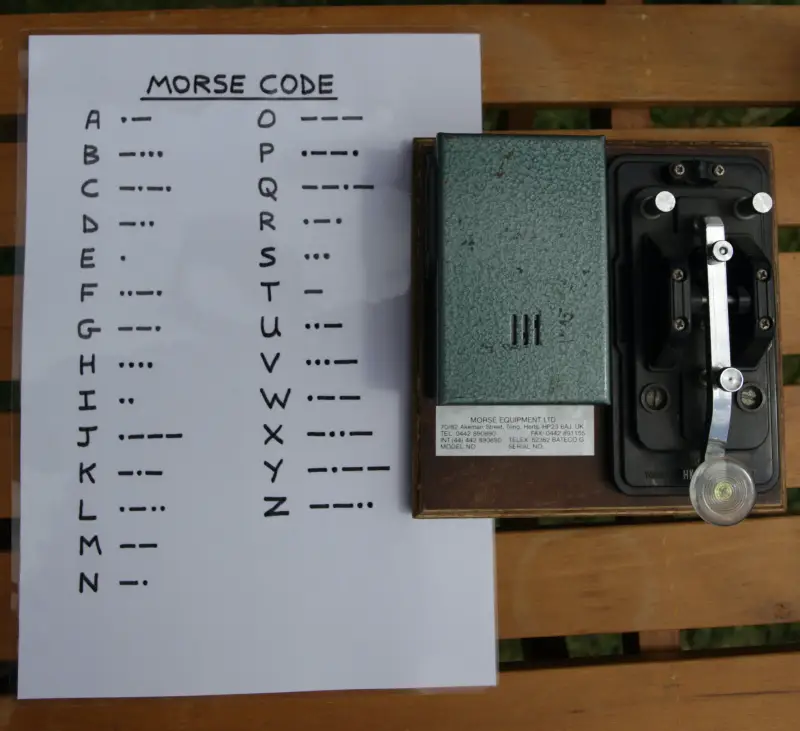If you are just starting to learn Morse code, then saying simple phrases with Morse code like “Hello” or “Hi” is often one of the first steps in learning Morse code, similar to how we learn basic phrases when studying English.
Use Morse code to say “Hello” or “Hi” in a fun and unique way to greet others. It’s simple and all you need to know is how to use dots (.) and dashes (- or _) to represent the letters.
Contents
How to Write “Hello” or “Hi” Text in Morse Code
Each letter in the English alphabet has a unique combination of dots (.) and dashes (- or _, here use -) in Morse code. It’s simple to convert the word ‘Hello,’ which has 5 letters, or ‘Hi,’ which has 2 letters, into Morse code:
- The Morse code for “Hello” is “…. . .-.. .-.. —“
- The Morse code for “Hi” is “…. ..”
Here is the breakdown of the Morse code for each letter in the words “Hello” and “Hi”:
- For “Hello”: …. (H) . (E) .-.. (L) .-.. (L) — (O)
- For “Hi”: …. (H) .. (I)
How to Say “Hello” or “Hi” in Morse Code
In Morse code, the dot (.) is pronounced as “Dit,” and the dash (-) is pronounced as “Dah.” Here is the pronunciation for each letter in the words “Hello” and “Hi”:
For “Hello”: (Dit-Dit-Dit-Dit) (Dit) (Dit-Dah-Dit-Dit) (Dit-Dah-Dit-Dit) (Dah-Dah-Dah)
Hello In Morse Code Audio
For “Hi”: (Dit-Dit-Dit-Dit) (Dit-Dit)
Hi In Morse Code Audio
So, to verbally communicate the message “Hello” in Morse code, you would say “Dit-Dit-Dit-Dit Dit Dit-Dah-Dit-Dit Dit-Dah-Dit-Dit Dah-Dah-Dah”, and you would say “Dit-Dit-Dit-Dit Dit-Dit” to say “Hi”.
What Are Morse Code Dots and Dashes?
Morse code is a method used to send messages or encode text characters, including both letters and numbers. In Morse code, two types of signals are used: dot and dash. Each letter and number can be represented by a unique combination of these dots and dashes. This way, you can spell out words and send messages using just these two types of signals.
- Dot: a short, quick pulse of signal, like a quick beep or flash of light.
- Dash: a longer signal, which is three times as long as a “Dot”. So, if we consider a “Dot” as one unit of time, a “Dash” would be three units of time.
How to Blink “Hello” Or “Hi” in Morse Code
To blink “Hello” or “Hi” in Morse code, you’ll need to use a series of short and long blinks to represent each letter. A “short blink” means a dot, and a “long blink” signifies a dash in Morse code.
Make sure to pause for a short time between each letter to clearly separate them, and a longer pause between words if you are blinking more than one word.
To Blink “Hello” in Morse Code:
- H: 4 short blinks (….)
- E: 1 short blink (.)
- L: 1 short blink, 1 long blink, 2 short blinks (.-..)
- L: 1 short blink, 1 long blink, 2 short blinks (.-..)
- O: 3 long blinks (—)
The following are the steps to blink “Hello”:
- Blink your eyes quickly 4 times for “H”
- Pause for a short time to separate the letters
- Blink your eyes quickly 1 time for “E”
- Pause for a short time to separate the letters
- Blink your eyes quickly 1 time, then slowly 1 time, then quickly 2 times for “L”
- Pause for a short time to separate the letters
- Repeat step 5 for the second “L”
- Pause for a short time to separate the letters
- Blink your eyes slowly 3 times for “O”
To Blink “Hi” in Morse Code:
- H: 4 short blinks (….)
- I: 2 short blinks (..)
Here is the sequence to blink “Hi”:
- Blink your eyes quickly 4 times for “H”
- Pause for a short time to separate the letters
- Blink your eyes quickly 2 times for “I”
Final Thought
Saying “Hello” or “Hi” in Morse Code is a creative way of greeting others, especially to impress your special one.
It is not just a unique form of communication, it also connects us to a rich history of telecommunication that dates back to the 19th century. Learning Morse code can be a fun and rewarding experience. It sharpens your mind, enhances your memory, and can even be a lifesaving skill in emergency situations where standard communication methods are not available.
